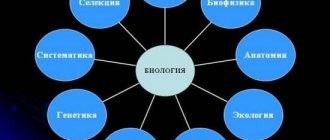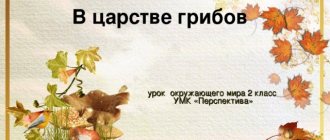LESSON DEVELOPMENTS IN BIOLOGY 7th grade for teaching materials V.M. Konstantinova - 2020
Thematic planning of educational material
GENERAL INFORMATION ABOUT THE ANIMALS
Lesson 1. Ornithological research as an introduction to the study of the animal kingdom
Lesson 2. Zoology - the science of animals
Lesson 3. Animals and the environment
Lesson 4. Classification of animals and main systematic groups
Lesson 5. Human influence on animals
Lesson 6. Brief history of the development of zoology
Lesson 7. Cage
Lesson 8. Tissues, organs and organ systems
Lesson 9. Generalization of knowledge on the topic “Structure of the body of animals”
TYPE COELENTERATA (Coelenterata)
Lesson 10. General characteristics of protozoa. Phylum Sarcodidae and flagellates (Sarcomastigophora). Sarcodaceae
Lesson 11. Phylum Sarcodidae and flagellates. Flagellates
Lesson 12. Type of Ciliates (Ciliophora)
Lesson 13. The meaning of protozoa
Lesson 14. General characteristics of the subkingdom Multicellular animals (Metazoa). The structure and vital functions of coelenterates
Lesson 15. The importance and diversity of Coelenterates
TYPES FLATWORMS (Plathelminthes), ROUNDWORMS (Nemathelminthes), RINGWORMS (Annelida)
Lesson 16. Type Flatworms (Plathelminthes)
Lesson 17. Diversity of flatworms: flukes and tapeworms
Lesson 18. Type Roundworms (Nemathelminthes)
Lesson 19. Type Annelida. Class Polychaete worms (Polychaeta)
Lesson 20. Type Annelida. Class Oligochaete worms
Lesson 21. Generalization of knowledge on the topic “Types of Flatworms, Roundworms and Annelids”
TYPE OF MOLLUSCA (Mollusca)
Lesson 22. General characteristics of mollusks
Lesson 23. Class Gastropoda
Lesson 24. Class Bivalves (Bivalvia)
Lesson 25. Class Cephalopods (Cephalopoda). Generalization of knowledge on the topic “Type of Molluscs”
TYPE ARTHROPODA (Arthropoda)
Lesson 26. General characteristics of arthropods. Class Crustaceans (Crustacea)
Lesson 27. Class Arachnida
Lesson 28. Class Insects (Insecta)
Lesson 29. Types of insect development
Lessons 30, 31. Social insects. Insects are pests of cultivated plants. The importance and protection of insects
Lesson 32. Generalization of knowledge on the topic “Type Arthropods”
Lesson 33. Generalization and systematization of knowledge on the topic “Invertebrate animals”
TYPE CHORDATA: SKULLLESS, FISHES
Lesson 34. General characteristics of chordates. Skullless (Acrania)
Lesson 35. Cranial, or vertebrate. External structure of fish
Lesson 36. Internal structure of fish
Lesson 37. Peculiarities of fish reproduction
Lesson 38. Basic systematic groups of fish. Commercial fish. Their use and protection.
Lesson 39. Generalization of knowledge on the topic “Type Chordata: skullless, fish”
CLASS Amphibians, OR AMPHIBIANS (Amphibia)
Lesson 40. General characteristics. Habitat and body structure of amphibians
Lesson 41. Structure and functions of internal organs of amphibians
Lesson 42. Annual life cycle and origin of amphibians
CLASS REPTILES, OR REPTILES (Reptilia)
Lesson 43. Diversity and importance of amphibians. Generalization of knowledge on the topic “Class Amphibians”
Lesson 44. General characteristics of reptiles. External structure and skeleton of reptiles
Lesson 45. Internal structure and vital functions of reptiles
Lesson 46. Diversity of reptiles
Lesson 47. The meaning and origin of reptiles. Generalization of knowledge on the topic “Class Reptiles”
BIRD CLASS (Aves)
Lesson 48. General characteristics of birds. External structure of birds
Lesson 49. The musculoskeletal system of birds
Lesson 50. Internal structure of birds
Lesson 51. Reproduction and development of birds. Annual life cycle and seasonal phenomena in the life of birds
Lesson 52. Diversity of birds
Lesson 53. The importance and protection of birds. Origin of birds
Lesson 54. Educational films about birds
Lesson 55. Generalization and systematization of knowledge on the topic “Bird Class”
CLASS MAMMALS OR ANIMALS (Mammalia)
Lesson 56. General characteristics. External structure of mammals
Lesson 57. Internal structure of mammals
Lesson 58. Reproduction and development of mammals. Annual life cycle
Lesson 59. Origin and diversity of mammals
Lesson 60. Higher, or placental, animals: insectivores, bats, rodents, lagomorphs, carnivores
Lesson 61. Higher, or placental, animals: pinnipeds and cetaceans, artiodactyls and equids, proboscis
Lesson 62. Higher, or placental, animals: primates
Lesson 63. Ecological groups of mammals
Lesson 64. The importance of mammals for humans
Lesson 65. Generalization of knowledge on the topic “Mammals or Animals”
DEVELOPMENT OF ANIMAL WORLD ON EARTH
Lesson 66. Evidence of the evolution of the animal world. Charles Darwin's doctrine of evolution
Lesson 67. Development of the animal world on Earth
Lesson 68. Generalization and systematization of knowledge on the topic “Vertebrates”
Lesson 69. Modern animal world
Development of a biology lesson “Introduction” for 7th grade students
1. Zoology - the science of animals(slide 2)
- Do you remember how the word “biology” is translated?
Notebook entry:
Biology (from the Greek “bios” - life, “logos” - science) is the science of living nature (slide 2).
- Which scientist first proposed the term “biology”? (slide 3).
The term "biology" was proposed in 1802 by the French scientist Jean Baptiste Lamarck.
All living organisms on Earth are united into kingdoms (slide 4).
- List the kingdoms that exist on Earth.
(Kingdoms: Viruses, Bacteria, Fungi, Plants, Animals).
- Tell me, what kingdoms did we meet in 6th grade?
That's right, in 6th grade, during biology lessons, you met representatives of the four kingdoms: Viruses, Bacteria, Fungi, Plants.
- What kingdom do you think we will study this year?
That's right, we are starting to study a new kingdom of living organisms - Animals
(slides 3-6).
- What is the name of the branch of biology devoted to the study of animals?
The branch of biology devoted to the study of animals, their diversity, structure and life activity, connections with the environment, distribution, individual and historical development, role in nature and significance for humans is called zoology
(from the Greek
zoon
- “animal”,
logos
- “teaching”)
(write in a notebook).
2. Modern zoology is
a system of animal sciences .
? What sciences are we already familiar with from 6th grade?
Among them morphology
and
anatomy
, the study of the external and internal structure of organisms,
- cytology
– their cellular structure (slides 3-6).
- Physiology
studies the activities of cells, organs, organ systems and entire organisms.
- Embryology
examines the individual development of organisms.
- Taxonomy
– classification of animals
- An important part of zoology is ecology
, which studies the relationships of animals with each other, as well as with other organisms and with their environment.
- Paleontology
explores fossil animals and their changes in the process of historical development.
The school zoology course includes the basics of other sciences
(slide 7):
- genetics
, explaining the patterns of heredity,
- zoogeography
– distribution of animals,
- ethology
- their behavior
Zoology studies various groups of animals, including
(slides 8-10):
- the special world of animals is represented by protozoa,
- parasitic worms,
- spiders,
- insects,
- fish,
- birds,
- mammals, etc.
Work in pairs:
Independent work with a textbook on the assignment:
Using the textbook “Biology. 7th grade” edited by K. Kayim on page 5, fill out the table “Biological disciplines within zoology” (time to complete – 10 minutes).
Table “Biological sciences and objects studied by them.”
№
| Biological science | What does he study? |
| 1 | |
| 2 | |
| 3 | |
| 4 | |
| 5 | |
| 6 | |
| 7 | |
| 8 | |
| 9 | |
| 10 | |
| 11 | |
| 12 |
3.
Similarities and differences between animals and plants
(slides 11-12):
Animals, like most other living organisms, are characterized by the following features:
1) cellular structure,
2) ability to eat,
3) breathing,
3) selection,
4) metabolism between the body and the environment,
5) reproduction, growth, development.
6) Animals are able to perceive irritations and respond to them.
7) They can move actively. Most of them get their own food and pursue prey.
 Animals have mastered all living environments: water, land, underground and air.
Animals have mastered all living environments: water, land, underground and air.
4. Difference between animals and plants
(slide 13):
How do animals differ from plants?
- Animal cells do not have a hard cellulose shell.
- Unlike plants, animals feed on ready-made organic substances.
- In natural communities they play the role of consumers (consumers) of organic matter.
- They perceive irritations and react to them.
- Most are actively moving.
- Mastered all environments of life.
Work in groups on assignment:
Fill out the table “Differences between plants and animals”:
| Comparison sign | Plants | Animals |
| Nutrition | ||
| Height | ||
| Movement | ||
| Gas exchange | ||
| Cell structure |
5). Diversity of animals
(slides 14-19):
Currently, there are about 2 million animal species on Earth. They are distributed throughout the globe. They live in seas, oceans, rivers, lakes, ponds; inhabit forests, meadows, fields; mastered the air and soil environments of life. Animals are known that live in plants and parasitize the organisms of other animals and humans.
The largest number of insects on Earth (butterflies, beetles, flies, bees, etc.) is more than 1 million species.
About 130 thousand species of mollusks are known: snails, slugs, pearl barley, squid.
Over 20 thousand species of fish inhabit different bodies of water.
Modern birds are few in number compared to other groups - 8,600 species, mammals - about 4,000 species.
Animals are very diverse in external and internal structure, size, and lifestyle.
Some move in water with the help of cilia, others - thanks to fins. Most land animals rely on their limbs to move. Insects, birds, and bats use wings to fly.
The smallest animals can only be seen under a microscope. Large land animals, such as elephants, reach a height of 3.5 m and have a mass of about 5 tons. The largest animal that has ever lived and is living on Earth is the blue whale
length up to 33 m and weight up to 150 tons.
6. The meaning of animals. Wild and domestic animals
(slides 20-22):
Work in groups on assignment:
Group 1 - The meaning of animals. Wild and domestic animals.
2nd group —
The negative role of animals in natural communities.
Group 3 - Game animals;
Group 4 - Generalization on the topic: The role of animals.
1st group:
Animals are diverse not only in appearance, structure, way of life, but also in the role they play in natural communities. Animals - pollinators
plants. These are butterflies, beetles, flies, bumblebees, bees, etc. Without them, the appearance of our forests, meadows, and fields would be completely different.
Many animals spread
fruits and seeds of plants. Some carry them on fur and feathers. In birds that feed on juicy fruits, the pulp is digested, and the seeds in a dense shell pass through the intestines without losing germination and spread over long distances
(slides 23-25):
Predatory insects, birds and animals regulate numbers
their victims, including many pests of cultivated plants.
Homework is extremely important for people
animals. We get food from them (milk, eggs, honey), wool, fluff, leather, silk. Pets do different jobs
The dog was one of the first (more than 10 thousand years ago) to be domesticated. Her ancestor was a wolf. Currently, more than 400 breeds of hunting, service and decorative dogs have been bred. In gratitude for his faithful service and devotion, people erected monuments to the dog.
Dog breeds
(slides 26-28):
The most famous dog monument, located in Paris, is dedicated to the Saint Bernard who saved 40 people from avalanches in the Alps.
- In Alaska, a monument was erected to the leader of the sled dogs, who took the lost rider back to the people.
- There are monuments to guide dogs, border guard dogs and those who remained faithful
to their owners after their death.
- In St. Petersburg there is a famous monument to a dog who suffered in the name of science. He was
built on the initiative of the great Russian physiologist Academician Ivan Petrovich Pavlov. His words are written on the pedestal: “Let the dog, man’s helper and friend since prehistoric times, be sacrificed to science, but our dignity obliges us to ensure that this happens without fail and always without unnecessary torment.”
(slides 29):
The domestication of cattle and horses was of greatest importance. From them people get meat, milk, and skins. In many areas, these animals are used as draft power when cultivating the land and as a means of transport. Most domesticated animals are mammals and birds.
Group 2:
The negative role of animals in natural communities
(slides 30 - 32):
Many of them harm the plants they feed on. Thus, the massive appearance of gypsy moth or ringed silkworm caterpillars causes enormous damage to forests. They damage leaves, buds, and young shoots.
Swarms of Asian migratory locusts completely destroy vegetation over vast areas, depriving other herbivorous animals of food. Such locust invasions deprive people of their harvest. Parasitic animals cause diseases in wild animals, domestic animals and humans.
Group 3:
Game
animals
(slide 33):
A person obtains a significant part of protein food through fishing in the seas and oceans, hunting sea animals, hunting wild boar, deer, waterfowl and forest birds.
Group 4 (slide 34-35):
- A). It is important for scientific research, training of biologists and doctors.
- breeding of laboratory animals - mice, rats, guinea pigs. They've been scamming me for a long time
- decorative aquarium fish, canaries, parrots, weavers.
B). The domestication of animals continues to this day. In recent decades, silver-black foxes, arctic foxes, minks, and nutria have been successfully domesticated. They are bred on fur farms. Work continues on the domestication of elk, wood grouse, and ostriches.
7. Animal protection
(slides 36 – 37)
.
After watching the video, answer the questions:
- Do you know what the Red Book is?
- What is it created for? What animals are protected in Kazakhstan?
- How many nature reserves are there in the Republic of Kazakhstan?
What does a biology textbook for 7th grade include (authors: V.V. Latyushin, V.A. Shapkin)
Sections of the online GDZ include the same topics that are included in the main book:
- Variety of animals;
- Evolution of the structure and functions of organs and their systems;
- Development and patterns of distribution of animals on earth;
- Biocenoses, etc.
Among other things, moms and dads can also use this collection. Thanks to him, they can easily check the level of knowledge of their baby. Since the correct answers are collected here, described in detail by professional teachers, any errors are excluded. Therefore, adults may not even think about the context; just look at the solutions.
For subject teachers, such manuals will be a faithful assistant in saving valuable time when checking notebooks. Also, with the help of it, they have the right to make cards for class activities or develop their own entertaining program for the lesson.
Now the student is not afraid to answer the teacher’s questions from the seat or the board; he himself will raise his hand to show off his knowledge.
basic notes on zoology - grade 7 methodological development in biology (grade 7) on the topic
The expediency of using reference notes is beyond doubt, since it is an integral part of the technology of intensification of learning based on schematic and symbolic models of educational material, proposed by V.F. Shatalov.
Visualization of educational material due to the illustrative nature of OK is especially important now that the younger generation is defined as the “moving picture” generation. At the same time, all students experience a lack of color and graphic sensations in the lesson, and this is fraught with a decrease in the level of perception of educational material.
OC develops in schoolchildren such skills as the ability to focus a problem, highlight goals, set priorities, collect and organize information, remember it, analyze, evaluate and present.
However, a serious attempt to provide the attention of practicing teachers with complete sets of OKs, adapted to modern textbooks and programs, has not been made since 1997, when the Prosveshcheniye publishing house published the collection “Active forms and methods of teaching biology” (compiled by L.V. Rebrova and E.V. Prokhorova), which united the OK of several teams of authors in all areas of biology.
This manual partially fills the gap, because includes OK in the course of zoology (biology - grade 7).
It consists of 19 OKs for the main systematic groups of animals studied at school. Each abstract has a detailed annotation
The author also tried to avoid linking the content of the OK to any specific textbook.
Each teacher has the right to independently choose the trajectory of using notes. This may be an explanation of new material (one-time or step-by-step), or it may be a generalization of the entire topic covered. For some limited OCs, it is possible to combine them into larger modules (for example, OC Nos. 15 – 19, i.e. Type Chordata: classes Cartilaginous and Bony fish, Amphibians, Reptiles, Birds and Mammals) with subsequent analysis of evolutionary transformations of various organ systems . A retrospective of such OCs within the framework of a general module creates all the conditions for students’ project activities (in class or as homework) to create a final creative OC.
The author considers the use of OK to prepare graduates for the Unified State Exam to be relevant and timely. Effectively performing the function of reference material, OK provides the opportunity not only to save global time, but also, due to the mnemonic laws by which it was created, it very clearly and reliably records this material in memory.
Biology - lessons, tests, presentations, notes
Create your teacher website PC and PPC courses Video lessons Olympiad Webinars for teachers
- home
- Biology
Watch and download free lessons, tests, notes, presentations and other useful materials on biology for teachers and students.
- All 11817
- Lessons 5224
- Presentations 2713
- Tests 822
- Planning 937
- Events 708
- Other 1413
- All classes
- For preschoolers
- 1 class
- 2nd grade
- 3rd grade
- 4th grade
- 5th grade
- 6th grade
- 7th grade
- 8th grade
- 9th grade
- Grade 10
- Grade 11
| Work program of the ecological circle The program of the ecological circle was developed for 9th grade students, implementation period is 1 year. ... 10/07/2020 Bodrov Kirill Nikolaevich 7 0 |
| Zherdin kurylysy men kuramy Zher galamsharynyn paida boluy. Zherdin kurlysy men kuramy… 10/07/2020 Shainova Dinara Kurmetkalievna 7 0 |
| Elective course in biology The proposed course is aimed at consolidation. systematization and deepening of knowledge of the material studied during the course of grades 6–8…. 09.30.2020 Cherkaeva Polina Vasilievna 12 0 |
Presentation “The importance of algae in nature and human life” Formation of cognitive culture among students... 10/09/2020 Gorbach Tatyana Anatolyevna 4 0 |
| Project on the topic: “Patriotic education in the classes of the “School Sports Club GTO” through research and project activities.” The project educates students to have a healthy lifestyle.... 08.28.2020 Vlasova Tatyana Stanislavovna 38 0 |
A package of documents for conducting an intermediate certification in biology in grade 11. This package of documents was developed for grade 11 of the KBOU “School of Distance Education” in Krasnoyarsk. The package of documents in PDF format contains three versions of test papers, critical… 06/25/2020 Rodygina Elena Anatolyevna. 61 1 |
| The most common pests are ladybug, frog, their lifestyle, nutrition, benefits of these animals. The most common pests; ladybug, frog, their lifestyle, nutrition, benefits of these animals... 05/17/2020 Nadezhda Vladimirovna Novikova 85 0 |
| Darilik qyrmyzygul gulderi komirkyshkyldy extracts negyzindegi silicon ontails kuramyn tandau "Kazakhstan - 2050" industrials ladies' strategy izattan zhana dәrі-dәrmektermen cosmetics ққұрлдир zhasau prospects baggy… 06/19/2020 Esmagambetova Dinara Askhatkyzy 79 0 |
| Presentation of work experience on the topic “Development of creative abilities in biology lessons and during extracurricular hours.” Presentation of pedagogical work experience contains the main methods and techniques for developing students’ creative abilities during biology lessons and during extracurricular hours…. 03/11/2020 Goncharova Lyudmila Viktorovna 98 0 |
| Conditions for the implementation of student-centered learning in biology lessons One of the conditions for student-centered learning is a differentiated approach... 09/14/2020 Chaika Tatyana Sergeevna 29 0 |
| Ecological problems in Kalmykia as factors of morbidity and mortality of the population The article examines the degree of anthropogenic transformation of natural landscapes. Based on the analysis of quantitative indicators and expert scoring, the severity of environmental... 06.29.2020 Imashev Kambar Azamatovich 48 0 |
| Technological map of the lesson “Structure and work of the heart. Circulation circles"" Technological map of the educational lesson "Structure and work of the heart. Circulation Circles” is compiled in accordance with new generation standards and meets the requirements of the Federal State Educational Standard. 06/03/2020 Nazarenko Natalya Sergeevna 72 0 |
| Summary of a biology lesson as part of the regional competition “Teacher of the Year 2020”. Topic: “Amphibians”, grade 7 The lesson complies with the Federal State Educational Standard. lesson type: discovery of new knowledge. technology: problem-based learning. Methods: problematic, partially search. forms of work: group, frontal. Problematic question: What p… 06/22/2020 Gainbikhner Evgeniy Aleksandrovich 77 1 |
| Abstract of a distance lesson on the topic “Musculoskeletal system. Features of the structure of the skeleton" This development is applicable to conducting a distance lesson in biology... 05/19/2020 Korotyaeva Tatyana Marisonovna 93 0 |
Project and research activities as a means of personal development Speech at a round table meeting, summarizing work experience... 11/07/2019 Mikhalenkova Elena Vladimirovna 98 1 |
| Biology lesson in 5th grade on the topic “On the border of living and nonliving: viruses” The lesson is structured in accordance with the requirements of the Federal State Educational Standard, a presentation is used. With the help of riddles, the topic of the lesson and the goals expressed by the children are determined. Material is being studied about the founder of the virus... 09/14/2020 Elena Nikolaevna Zamorova 44 0 |
| Interactive game "Characteristics of subclasses of the class Mammals" this development will allow in a playful form to consolidate knowledge about the characteristics of subclasses of the class Mammals:: primal beasts, marsupials, placentals... 09.24.2020 Korotyaeva Tatyana Marisonovna 23 0 |
| Biotic environmental factors. Relationships between organisms. This presentation presents theoretical and visual material for the lesson “Biotic environmental factors. Relationships between organisms."... 06/04/2020 Vasilyeva Henrieta Evgenievna 96 0 |
| Cellular structure of organisms Development of a lesson on the topic “Cellular structure of an organism”…. 10/09/2020 Pronina Evgenia Pavlovna 3 0 |
| Lesson on the topic “Class Mammals. Features of the external structure." Topic: Class Mammals. Features of the external structure. Objectives: to show the progressive features of the organization of mammals that allowed them to spread widely… 09.30.2020 Prishletsova Oksana Vladimirovna 10 0 |
- ← Back
- Continue →



